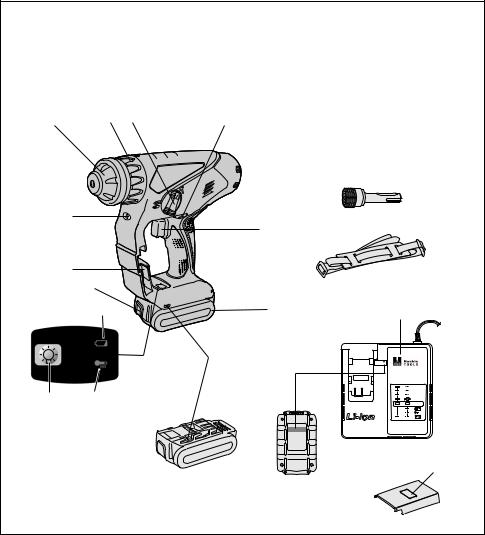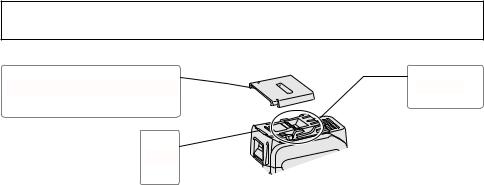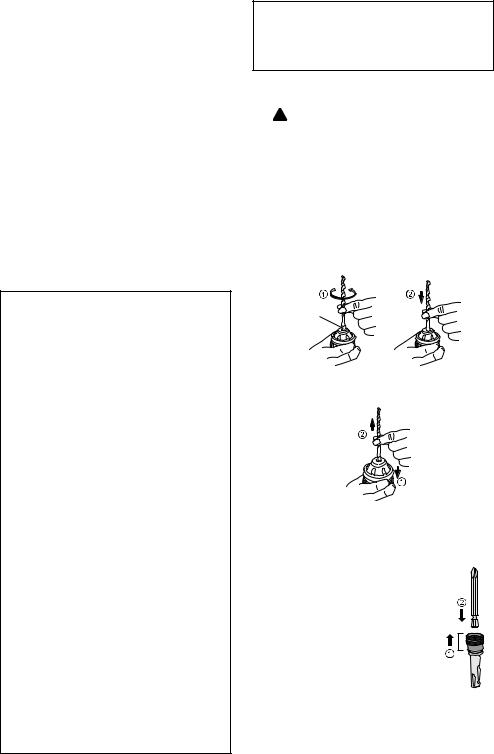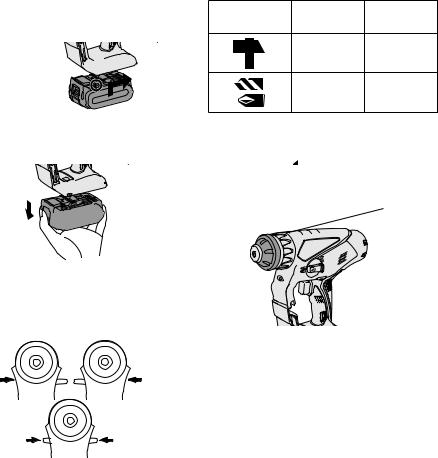Panasonic htp-rth Operation Manual

Cordless Rotary Hammer Drill & Driver Destornillador y martillo de taladro rotatorio sin cables
Operating Instructions
Manual de instrucciones
Model No: HTP-RTH
IMPORTANT
This manual contains safety information. Read manual completely before first using this product and save this manual for future use.
IMPORTANTE
Este manual contiene información de seguridad. Lea completamente este manual antes de utilizar por primera vez este producto, y guárdelo para poder consultarlo en el futuro.

Index/Index/Indice |
|
|
|
|
English: |
Page |
5 |
|
|
Español: |
Página |
18 |
|
|
FUNCTIONAL DESCRIPTION |
|
|||
DESCRIPCIÓN FUNCIONAL |
|
|||
(A) |
(B) (C) |
(D) |
|
|
(N) |
|
(E) |
(O) |
|
|
|
|
|
|
(M) |
|
|
(P) |
|
|
(L) |
|
|
|
|
|
|
|
|
|
(K) |
|
(F) |
(Q) |
|
|
|
|
|
|
|
(H) |
(G) |
|
|
|
(G) |
|
|
|
|
|
10.8 V 28.8 V |
|
|
|
|
|
|
(J) |
(I) |
|
|
|
|
|
|
|
(R) |

(A) |
Chuck |
|
Portabroca |
(B) |
Clutch handle |
|
Mango de embrague |
(C) |
Hammering/drilling |
|
Palanca de conmutación de |
switching lever |
|
martillo/taladro |
|
(D) |
Forward/Reverse lever |
|
Palanca de avance/inversión |
|
|
|
|
(E) |
Variable speed control |
|
Disparador del control de |
trigger |
|
velocided variable |
|
(F) |
Battery pack |
|
Batería |
(G) |
Alignment marks |
|
Marcas de alineación |
(H) |
Control panel |
|
Panel de controle |
(I) |
Overheat warning lamp |
|
Luz de advertencia de sobrecalen- |
(battery) |
|
tamiento (batería) |
|
(J) |
LED light ON/OFF button |
|
Botón ON/OFF de luz LED |
|
|
|
|
(K) |
Battery low warning lamp |
|
Luz de aviso de baja carga de |
|
batería |
||
|
|
|
|
(L) |
Battery pack release |
|
Botón de liberación de batería |
|
button |
|
|
(M) |
Bit adapter holder |
|
Soporte de adaptador de broca |
(N) |
LED light |
|
Luz indicadora |
(O) |
Bit adapter (EY9HX403E) |
|
Adaptador de broca (EY9HX403E) |
(P) |
Shoulder strap |
|
Correa al hombro |
(Q) |
Battery charger |
|
Cargador de batería |
(R) |
Pack cover |
|
Cubierta de batería |
|
|
|
|
Recommendations for use / Recomendaciones par el uso
Pack cover |
Terminals |
|
Bornes |
||
Couvercle de la batterie autonome |
||
Terminales |
||
Cubierta de batería |
||
|
||
label |
|
|
rouge |
|
|
rojo |
|

EN
FR
ES
Be sure to use the Pack cover
• When the battery pack is not being used, store the battery in a way that foreign substances such as dust and water etc. do not contaminate the terminals. Be sure to attach the battery pack cover to protect the battery terminals.
• When charging the battery pack, confirm that the terminals on the battery charger are free of foreign substances such as dust and water etc. Clean the terminals before charging the battery pack if any foreign substances are found on the terminals.
The life of the battery pack terminals may be affected by foreign substances such as dust and water etc. during operation.
CAUTION: To protect the motor or battery, be sure to note the following when carrying out this operation.
• If the motor or battery becomes hot, the protection function will be activated and the motor or battery will stop operating.
The overheat warning lamp on the control panel illuminates or flashes when this feature is active.
For safe use
•The battery pack is designed to be installed by proceeding two steps for safety. Make sure the battery pack is installed properly to the main body before use.
•If the battery pack is not inserted firmly when the switch is switched on, the overheat warning lamp and the battery low warning lamp will flash to indicate that safe operation is not possible, and the bit will not rotate normally. Insert the battery pack into the body of the tool until the red label disappears.
Veillez à utiliser le couvercle de la batterie autonome |
|
|
|||||
Asegúrese• Lorsque le couverclede utilizarde la batteriela cubiertatonome n’estdepasla cajautilisé, derangezbateríala batterie de façon à ce qu’aucun corps |
|||||||
• |
|
no utilice la caja de batería, guarde la batería de tal forma que las materias extrañas tales como polvo |
|||||
|
Cuandoétr ger comme de la poussière et de l’eau ne contamine les bornes. Veillez à fixer le couvercle de la batterie |
||||||
|
y agua, etc. ensucien los |
. |
de colocar la cubierta de la caja de batería de tal forma de |
||||
|
autonome afin de protégerterminalesbornesAsegúresede la batterie. |
|
|
||||
|
proteger los |
de la batería. |
|
|
|
||
• Lors de la chaterminalesge de la batterie autonome, assurez-vous que les bornes du chargeur de batterie sont libres de |
|||||||
• Cuando cargue la caja de batería, confirme que los terminales en el cargador de batería estén libres de |
|||||||
|
tout corps étranger comme de la poussière et de l’eau, etc. Nettoyez les bornes avant de charger la batterie |
||||||
|
materias extrañas tales como polvo y agua, etc. Limpie los terminales antes de cargar la caja de batería si hay |
||||||
|
autonome si des corps étrangers se trouvent sur les bornes. |
|
|
||||
|
materias extrañas en los terminales. |
|
|
|
|||
|
La durée de vie des bornes de la batterie autonome peut être affectée par des corps étrangers comme de la |
||||||
|
La vida de los terminales de la caja de batería puede verse afectada por materias extrañas tales como polo y |
||||||
|
poussière et de l’eau, etc. pendant le fonctionnement. |
|
|
||||
|
agua, etc. durante su funcionamiento. |
|
|
|
|||
|
MISE EN GARDE: Pour protéger le moteur ou la batterie, veillez à bien noter les points suivants lorsque |
||||||
|
PRECAUCIÓN: Para proteger el motor o la batería, asegúrese de observar lo siguiente cuando efectúe |
||||||
|
|
|
vous effectuez cette opération. |
|
|
||
|
|
|
esta operación. |
|
|
|
|
• Si le moteur ou la batterie deviennent chauds, la fonction de protection sera activée et le moteur ou la batterie |
|||||||
• Si el |
o la batería se calienta, se activará la función de protección y el motor |
la batería dejará de |
|||||
|
cessermotornt de fonctionner. Le témoin d'avertissement de surchauffe s'allume ou clignote sur le panneau de |
||||||
|
funcionar. La lámpara de |
|
sobrecalentamiento en el panel de control se ilumina o destella |
||||
|
commande lorsque cette advertenciacarac éristiquede est active. |
|
|
||||
|
cuando esta característica está activada. |
|
|
|
|||
Pour un usage sans risque |
|
|
|
||||
Para• La batterieun usoest conçuemáspourseguroêtre installée en procédant en deux étapes pour des raisons de sécurité. Assurez- |
|||||||
• La batería está diseñada para instalarse siguiendo dos pasos por motivos de seguridad. |
|
||||||
|
vous que la batterie est mise en place correctement avant d'utiliser l'outil. |
|
|
||||
|
Compruebe que la batería está instalada correctamente en el cuerpo principal antes de utilizar la herramienta. |
||||||
• Lorsque la batterie autonome n'est pas fermement insérée, le témoin d'avertissement de surchauffe et le témoin |
|||||||
• Si la batería no ha quedado bien introducida, la luz de advertencia de sobrecalentamiento y la luz de aviso de |
|||||||
|
d’avertissement de batterie basse clignotent et la machine ne fait pas tourner la mèche comme habituellement |
||||||
|
baja carga de batería parpadearán, y la broca no girará del modo habitual para |
al |
de que la |
||||
|
pour nous signaler que la machine ne fonctionne pas en toute sécurité même si unalertarin errupteuroperarioété enclenché. |
||||||
máquina no funcionará de manera segura si se acciona algún interruptor. Introduzca la batería en el cuerpo de
Insérez la batterie autonome dans le corps de l'outil jusqu'à ce que l'indicateur rouge disparaisse. la herramienta hasta que el indicador rojo desaparezca.

This tool, as a complete unit with a battery pack, satisfies appropriate IP Degrees of Protection based on the IEC regulations.
Definition of IP code
IP5X: Ingress of dust is not totally prevented, but dust shall not penetrate in a quantity to interfere with satisfactory operation of the tool or to impair safety (In case that the talcum powder under 75 μm intrudes inside the tool)
IPX6: Water projected in powerful jets against the tool from any direction shall have no harmful effects (In case that, with a nozzle of 12.5 mm inner diameter, approximately 100 L/min of normal temperature water is injected to the tool for 3 minutes from 3 meter distance)
LIMITED WARRANTY
The rating of IP56 qualifies this tool for the minimum impact of water or dust, but not for the assurance of performance in such conditions. See Safety and Operating Instructions for further details for proper operation.
 . INTRODUCTION
. INTRODUCTION
This tool is a Rotary Hammer for drilling in concrete. In addition, the tool has a “rotation only mode” without hammering. The mode is suitable for drilling and screw-fastening.
 . GENERAL SAFE-
. GENERAL SAFE-
TY RULES
 WARNING! Read all instructions
WARNING! Read all instructions
Failure to follow all instructions listed below may result in electric shock, fire and/or serious injury. The term “power tool” in all of the warnings listed below refers to your main operated (corded) power tool and battery operated (cordless) power tool.
SAVE THESE INSTRUCTIONS
Work Area Safety
1)Keep work area clean and well lit.
Cluttered or dark areas invite accidents.
2)Do not operate power tools in explosive atmospheres, such as in the presence of flammable liquids, gases or dust.
Power tools create sparks which may ignite the dust or fumes.
3)Keep children and bystanders away while operating a power tool.
Distractions can cause you to lose control.
Electrical Safety
1)Power tool plugs must match the outlet. Never modify the plug in any way. Do not use any adapter plugs with earthed (grounded) power tools.
Unmodified plugs and matching outlets will reduce risk of electric shock.
2)Avoid body contact with earthed or grounded surfaces such as pipes, radiators, ranges and refrigerators.
There is an increased risk of electric shock if your body is earthed or grounded.
3)Do not expose power tools to rain or wet conditions.
Water entering a power tool will increase the risk of electric shock.
4)Do not abuse the cord. Never use the cord for carrying, pulling or unplugging the power tool. Keep cord away from heat, oil, sharp edges or moving parts.
Damaged or entangled cords increase the risk of electric shock.
5)When operating a power tool outdoors, use an extension cord suitable for outdoor use.
Use of a cord suitable for outdoor use reduces the risk of electric shock.
Personal Safety
1)Stay alert, watch what you are doing and use common sense when operating a power tool. Do not use a power tool while you are tired or under the influence of drugs, alcohol or medication.
A moment of inattention while operating power tools may result in personal injury.
2)Use safety equipment. Always wear eye protection.
Safety equipment such as dust mask, non-skid safety shoes, hard hat, or hearing protection used for appropriate conditions will reduce personal injuries.
3)Avoid accidental starting. Ensure the switch is in the off position before plugging in.
Carrying power tools with your finger on the switch or plugging in the power tools that have the switch on invites accidents.
4)Remove any adjusting key or wrench before turning the power tool on.
A wrench or a key left attached to a rotating part of the power tool may result in personal injury.
5)Do not overreach. Keep proper footing and balance at all times.
This enables better control of the power tool in unexpected situations.
6)Dress properly. Do not wear loose clothing or jewelry. Keep your hair, clothing and gloves away from moving parts.
Loose clothes, jewelry or long hair can be caught in moving parts.
7)If devices are provided for the connection of dust extraction and collection facilities, ensure these are connected and properly used.
Use of these devices can reduce dust related hazards.
Power Tool Use and Care
1)Do not force the power tool. Use the correct power tool for your application.
The correct power tool will do the job better and safer at the rate for which it was designed.
2)Do not use the power tool if the switch does not turn it on and off.
Any power tool that cannot be controlled with the switch is dangerous and must be repaired.
3)Disconnect the plug from the power source and/or the battery pack from the power tool before making any adjustments, changing accessories, or storing power tools.
Such preventive safety measures reduce the risk of starting the power tool accidentally.
4)Store idle power tools out of the reach of children and do not allow persons unfamiliar with the power tool or these instructions to operate the power tool.
Power tools are dangerous in the hands of untrained users.
5)Maintain power tools. Check for misalignment or binding of moving parts, breakage of parts and any other condition that may affect the power tools operation. If damaged, have the power tool repaired before use.
Many accidents are caused by poorly maintained power tools.
6)Keep cutting tools sharp and clean.
Properly maintained cutting tools with sharp cutting edges are less likely to bind and are easier to control.
7)Use the power tool, accessories and tool bits etc. in accordance with these instructions and in the manner intended for the particular type of power tool, taking into account the working conditions and the work to be performed.
Use of the power tool for operations different from those intended could result in a hazardous situation.
Battery Tool Use and Care
1)Ensure the switch is in the off position before inserting battery pack.
Inserting battery pack into power tools that have the switch on invites accidents.
2)Recharge only with the charger specified by the manufacturer.
A charger that is suitable for one type of battery pack may create a risk of fire when used with another battery pack.
3)Use power tools only with specifically designated battery packs.
Use of any other battery packs may create a risk of injury and fire.
4)When battery pack is not in use, keep it away from other metal objects like paper clips, coins, keys, nails, screws, or other small metal objects that can make a connection from one terminal to another.
Shorting the battery terminals together may cause burns, or a fire.
5)Under abusive conditions, liquid may be ejected from battery; avoid contact. If contact accidentally occurs, flush with water. If liquid contacts eyes, additionally seek medical help.
Liquid ejected from the battery may cause irritation or burns.

Service
1)Have your power tool serviced by a qualified repair person using only identical replacement parts.
This will ensure that the safety of power tool is maintained.

 . SPECIFIC SAFE-
. SPECIFIC SAFE-
TY RULES
1)Wear ear protectors. Exposure to noise can cause hearing loss.
Use auxiliary handles supplied with the tool. Loss of control can cause personal injury.
2)Hold power tools by insulated grip ping surfaces when performing an operation where the cutting tool may contact hidden wiring.
Contact with a “live” wire will make exposed metal parts of the tool “live” and shock the operator.
3)Be aware that this tool is always in an operating condition, since it does not have to be plugged into an electrical outlet.
4)If the bit becomes jammed, immediately turn the trigger switch off to prevent an overload which can damage the battery pack or motor. Use reverse motion to loosen jammed bits.
5)Do not operate the Forward/Reverse lever when the trigger switch is on. The battery will discharge rapidly and damage to the unit may occur.
6)When storing or carrying the tool, set the Forward/Reverse lever to the center position (switch lock).
7)Do not strain the tool by holding the speed control trigger halfway (speed control mode) so that the motor stops. The protection circuit will activate and may prevent speed control operation. If this happens, release the speed control trigger and squeeze again for normal operation.
8)Be careful not to get dust inside the chuck.
9)Do not touch the rotating parts to avoid injury.
10)Do not use the tool continuously for a long period of time. Stop using the tool from time to time to avoid temperature rise and heat overload of the motor.
11)Do not drop the tool.
12)Do not put the tool on the place where the chuck is depressed. The bit may come off from the chuck and fall down when the chuck is depressed. It may cause injuries.
Symbol |
meaning |
||||||
|
|
V |
Volts |
||||
|
|
|
|
|
|
|
|
|
|
|
|
|
|
|
Direct current |
|
|
|
|
|
|
|
|
|
|
|
|
|
|
|
|
|
|
n0 |
No load speed |
||||
|
|
|
|
|
|
|
|
… min-1 |
Revolutions or |
||||||
|
|
|
|
|
|
|
reciprocation per minutes |
|
|
|
|
|
|
|
Rotation with hammering |
|
|
|
|
|
|
|
|
|
|
|
|
|
|
|
|
|
|
|
|
|
|
|
Rotation only |
|
|
|
|
|
|
|
|
WARNING:
Some dust created by power sanding, sawing, grinding, drilling, and other construction activities contains chemicals known to the State of California to cause cancer, birth defects or other reproductive harm. Some examples of these chemicals are:
*Lead from lead-based paints.
*Crystalline silica from bricks and cement and other masonry products.
*Arsenic and chromium from chemically-treated lumber.
To reduce your exposure to these chemicals: work in a well ventilated area, and work with approved safety equipment, such as dust masks that are specially designed to filter the microscopic particles.
 . FOR BATTERY
. FOR BATTERY
C H A R G E R & BATTERY PACK

Important Safety Instructions
1)SAVE THESE INSTRUCTIONS-This manual contains important safety and operating instructions for battery charger.
2)Before using battery charger, read all instructions and cautionary markings on (1) battery charger, (2) battery pack.
3)CAUTION - To reduce the risk of injury, charge only Huskie Tools Battery Pack as shown in last page.
Other types of batteries may burst causing personal injury and damage.
4)Do not expose charger to rain or snow.
5)To reduce the risk of damaging the electric plug and cord, pull by plug rather than cord when disconnecting charger.
6)Make sure cord is located so that it will not be stepped on, tripped over, or otherwise subjected to damage or stress.
7)An extension cord should not be used unless absolutely necessary. Use of improper extension cord could result in a risk of fire and electric shock. If extension cord must be used, make sure:
a.that pins on plug of extension cord are the same number, size and shape as those of plug on charger.
b.that extension cord is properly wired and in good electrical condition.
c.that wire size is large enough for ampere rating of charger as specified below.
RECOMMENDED MINIMUM AWG SIZE OF
EXTENSION CORDS FOR
BATTERY CHARGERS
AC Input Rating. |
Amperes |
AWG Size of Cord |
|||
Equal to or |
But less |
Length of Cord, Feet |
|||
greater than |
than |
25 |
50 |
100 150 |
|
0 |
2 |
18 |
18 |
18 |
16 |
8)Do not operate charger with damaged cord or plug replace them immediately.
9)Do not operate charger if it has received a sharp blow, been dropped, or otherwise damaged in any way; take it to a qualified serviceman.
10)Do not disassemble charger; take it to a qualified serviceman when service or repair is required. Incorrect reassembly may result in a risk of electric shock or fire.
11)To reduce the risk of electric shock, unplug charger from outlet before attempting any maintenance or cleaning.
12)The charger and battery pack are specifically designed to work together. Do not attempt to charge any other cordless tool or battery pack with this charger.
13)Do not attempt to charge the battery pack with any other charger.
14)Do not attempt to disassemble the battery pack housing.
15)Do not store the tool and battery pack in locations where the tempera ture may reach or exceed 50°C (122°F) (such a metal tool shed, or a car in the summer), which can lead to deterioration of the storage battery.
16)Do not charge battery pack when the temperature is BELOW 0°C (32°F) or ABOVE 40°C (104°F). This is very important.
17)Do not incinerate the battery pack. It can explode in a fire.
18)Avoid dangerous environment. Do not use charger in damp or wet locations.
19)The charger is designed to operate on standard household electrical power only. Do not attempt to use it on any other voltage!
20)Do not abuse cord. Never carry charger by cord or yank it to disconnect from outlet. Keep cord away from heat, oil and sharp edges.
21)Charge the battery pack in a well ventilated place, do not cover the charger and battery pack with a cloth, etc., while charging.
22)Use of an attachment not recommended may result in a risk of fire, electric shock, or injury to persons.

23)Do not short the battery pack. A battery short can cause a large current flow, over heating and burns.
24)NOTE: If the supply cord of this appliance is damaged, it must only be replaced by a repair shop appointed by the manufacturer, because special purpose tools are required.
25)TO REDUCE THE RISK OF ELECTRIC SHOCK, THIS APPLIANCE HAS A POLARIZED PLUG (ONE BLADE IS WIDER THAN THE OTHER).
This plug will fit in a polarized outlet only one way. If the plug does not fit fully in the outlet, reverse the plug. If it still does not fit, contact a qualified electrician to install the proper outlet. Do not change the plug in any way.
WARNING:
•Do not use other than the Huskie Tools battery packs that are designed for use with this rechargeable tool.
•Huskie Tools is not responsible for any damage or accident caused by the use of the recycled battery pack and the counterfeit battery pack.
•Do not dispose of the battery pack in a fire, or expose it to excessive heat.
•Do not drive the likes of nails into the battery pack, subject it to shocks, dismantle it, or attempt to modify it.
•Do not allow metal objects to touch the battery pack terminals.
•Do not carry or store the battery pack in the same container as nails or similar metal objects.
•Do not charge the battery pack in a high-temperature location, such as next to a fire or in direct sunlight. Otherwise, the battery may overheat, catch fire, or explode.
•Never use other than the dedicated charger to charge the battery pack. Otherwise, the battery may leak, overheat, or explode.
•After removing the battery pack from the drill or the charger, always reattach the back cover. Otherwise, the battery contacts could be shorted, leading to a risk of fire.
• When the Battery Pack Has Deteriorated, Replace It with a New One.
Continued use of a damaged battery pack may result in heat generation, ig-
 . ASSEMBLY
. ASSEMBLY
 CAUTION:
CAUTION:
Use of a concrete drill bit larger than the recommended size may cause damage to the tool.
1. To insert the bit
1-1.Insert a bit into the mounting hole, and turn it slightly to locate an engaged position.
1-2.At the engaged position, push the bit as far as it goes. Make sure that the bit is fixed by pulling it.
SDS PLUS type shank
2. To remove the bit
2-1.Depress the chuck and pull the bit.
Bit adapter
Use a bit adapter (O) and bit.
1.Remove the bit adapter from the bit adapter holder on the main unit.
2.Pull the bit holder. ( )
)
3.Insert the bit. ( )
)
4.Make sure the bit is inserted firmly by pulling it lightly.
5.Insert the bit adapter into the mounting hole and turn to locate an engaged position.
6.At the engaged position, push in as far as it goes.
•Make sure it does not move by pulling it lightly.

Attaching or Removing Battery Pack
1.To connect the battery pack:
Line up the alignment marks and attach the battery pack.
 Slide the battery pack until it locks into position.
Slide the battery pack until it locks into position.
Alignment marks
2.To remove the battery pack:
Pull the button from the front to release the battery pack.
Button 

 . OPERATION
. OPERATION
Forward/Reverse Lever
Forward |
Reverse |
Lock
 Be sure to set the lever in the center to lock it after use.
Be sure to set the lever in the center to lock it after use.
 Operate the Forward/Reverse lever after the motor rotation is completely stopped.
Operate the Forward/Reverse lever after the motor rotation is completely stopped.
Hammering/Drilling Switching Lever
NOTE: Operate the mode change after the motor rotation is completely stopped.
Position of |
Action mode |
Operation |
|
switching lever |
|||
|
|
Rotation with Concrete hammering Drilling,
Block Drilling
Screw
Rotation only Fastening,
Drilling
Clutch Torque Setting
Adjust the torque to one of the 5 clutch settings or “ ” position.
” position.
CAUTION:
Test the setting before actual operation. Set the scale at this mark ( ).
).
Variable Speed Control Trigger
To set the center of a hole, pull the trigger slightly to start the drill rotation slowly.
The more the speed control trigger is pulled, the higher the speed becomes.
CAUTION:
When operating the tool by pulling the trigger, there may be a momentary lag before rotation starts. This does not signal a malfunction.
 This lag occurs as the tool’s circuitry starts up when the trigger is pulled for the first time after installing a new battery pack or after the tool has not been used for at least 1 minute (or at least 5 minutes when the LED is on). Rotation will start without any lag during second and subsequent operations.
This lag occurs as the tool’s circuitry starts up when the trigger is pulled for the first time after installing a new battery pack or after the tool has not been used for at least 1 minute (or at least 5 minutes when the LED is on). Rotation will start without any lag during second and subsequent operations.

Control Panel
(1) |
|
|
|
|
|
(3) |
|
|
|
|
|
||||
|
|
|
|
|
(2) |
||
|
|
|
|
|
|||
|
|
|
|
||||
|
|
|
|
|
|
|
|
|
|
|
|
|
|
|
|
(1) LED light
Pressing  toggles the LED light on and off.
toggles the LED light on and off.
The light illuminates with
very low current, and it
does not adversely af-
fect the performance of the driver during use or its battery capacity.
CAUTION:
•The built-in LED light is designed to illuminate the small work area temporarily.
•Do not use it as a substitute for a regular flashlight, since it does not have enough brightness.
This product has the built-in LED light. This product is classified into “Class 1 LED Product” to IEC (EN) 60825-1:2001.
LED RADIATION
DO NOT STARE INTO BEAM
CLASS 1 LED PRODUCT
Use of controls or adjustments or performance of procedures other than those specified herein may result in hazardous radiation exposure.
(2) Overheat warning lamp
Off |
Illuminated: |
Flashing: |
(normal |
Overheat |
Overheat |
operation) |
(motor) |
(battery) |
Indicates operation has been halted due to motor or battery overheating.
To protect the motor or battery, be sure to note the following when carrying out this operation.
•If the motor or battery becomes hot, the protection function will be activated and the motor or battery
will stop operating. The overheat warning lamp on the control panel illuminates or flashes when this feature is active.
•If the overheating protection feature activates, allow the tool to cool thoroughly (at least 30 minutes). The tool is ready for use when the overheat warning lamp goes out.
•Avoid using the tool in a way that causes the overheating protection feature to activate repeatedly.
•If the tool is operated continuously under high-load conditions or if it is used in hot-temperature conditions (such as during summer), the overheating protection feature may activate frequently.
•If the tool is used in coldtemperature conditions (such as during winter) or if it is frequently stopped during use, the overheating protection feature may not activate.
•The performance of the EY9L42 deteriorates significantly at and below 10°C due to work conditions and other factors.
•The ambient temperature range is between 0°C (32°F) and 40°C (104°F). If the battery pack is used when the battery temperature is below 0°C (32°F), the tool may fail to function properly.
•Use the charger at temperatures between 0°C and 40°C, and charge the battery at a temperature similar to that of the battery itself. (There should be no more than a 15°C difference between the temperatures of the battery and the charging location.)

(3) Battery low warning lamp
Off |
Flashing |
(normal |
(No charge) |
operation) |
Battery protection |
|
feature active |
Excessive (complete) discharging of lithium ion batteries shortens their service life dramatically. The driver includes a battery protection feature designed to prevent excessive discharging of the battery pack.
•The battery protection feature activates immediately before the battery loses its charge, causing the battery low warning lamp to flash.
•If you notice the battery low warning lamp flashing, charge the battery pack immediately.
•If it is started with too little battery power remaining, the tool may stop operating without the battery low warning lamp flashing first. This indicates that there is too little battery power remaining to use the tool, and the battery pack should be charged before further use.
•If the tool is subject to a sudden load during use that causes the motor to lock up, the overdischarge prevention sensor may be triggered, and the battery low warning lamp may flash. The lamp will stop flashing once you address the cause of the motor’s locking up and cycle the trigger.
•The battery protection feature may activate when a high load is abruptly placed on the motor, even if ample battery charge remains. In this case, both the battery low warn-ing lamp and LED light will flash. (HTPRH)
•If both the battery low warning lamp and LED light flash, reduce the force with which you are pushing on the driver or, if using a drill driver, adjust the speed switch to a lower setting. (HTP-RH)
Installing the Shoulder Strap
CAUTION:
•Install the shoulder strap firmly to the main unit of the tool and check the length of the strap before use.
•Check the condition of the strap and do not use if it is cut or torn etc.
There is a risk of injury or damage if used while improperly installed.
•Please wear the shoulder strap securely on the shoulder.
There is a risk of injury or damage if it is accidentally dropped.
1.Pass the strap through the strap holders. ( )
)
2.Pass the strap through the buckles and adjust the length. ( )
)
Shoulder pad 
•The shoulder strap can be adjusted according to the individual.
•Adjust the shoulder pad to the shoulder.
•Pull the shoulder strap to make sure it is firmly attached to the main unit of the tool.
